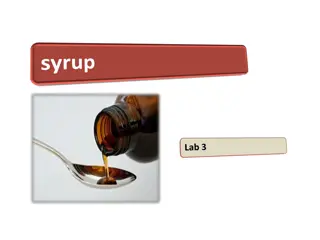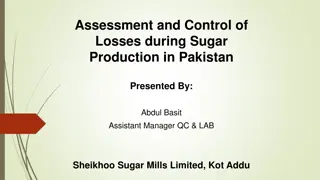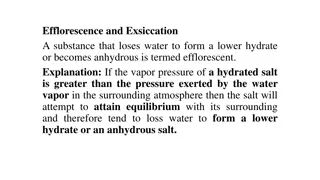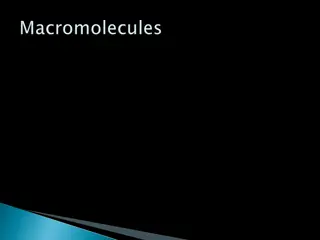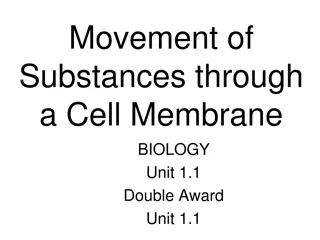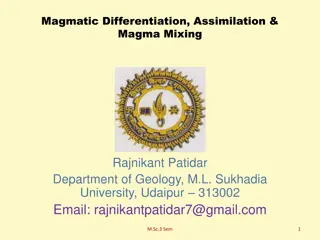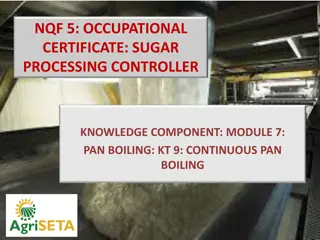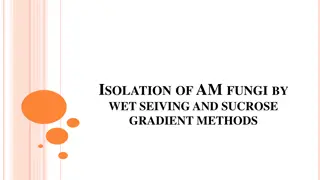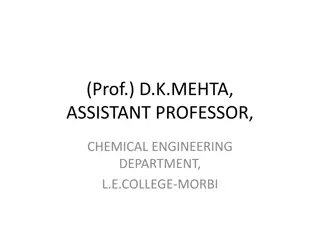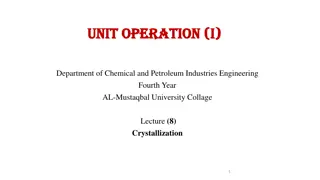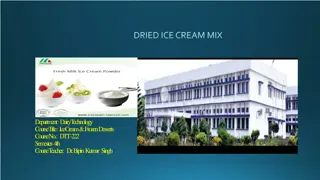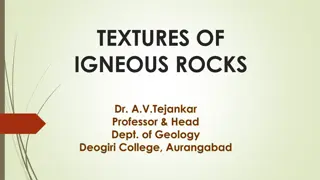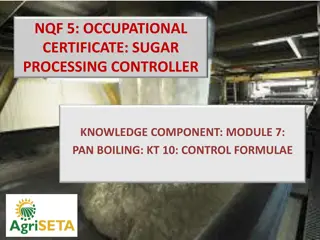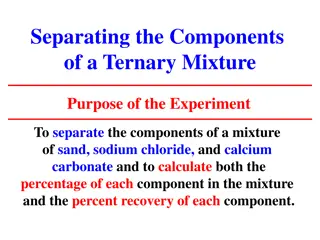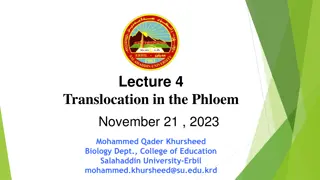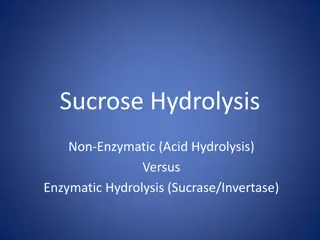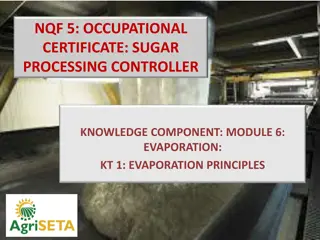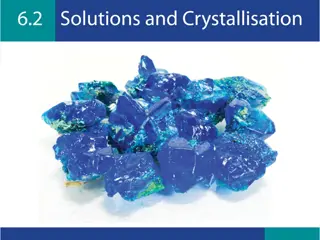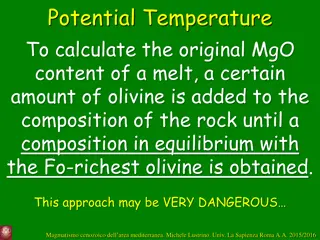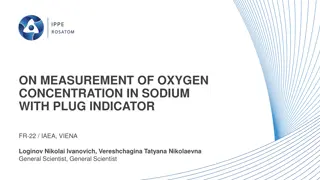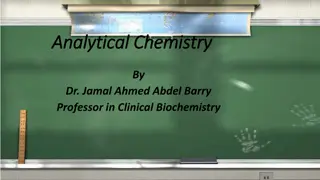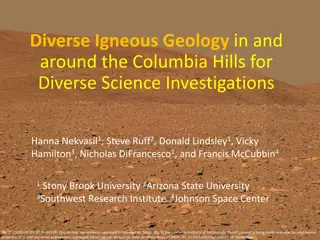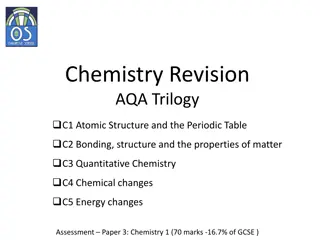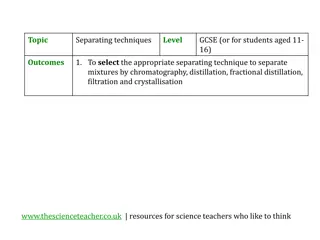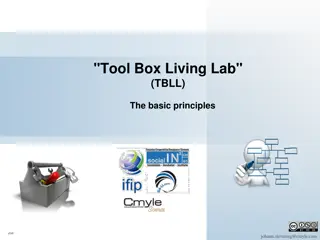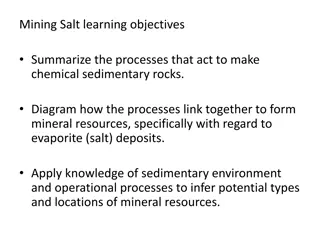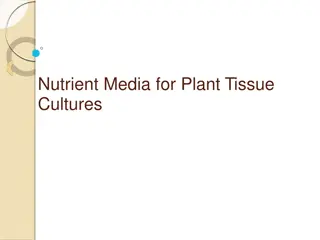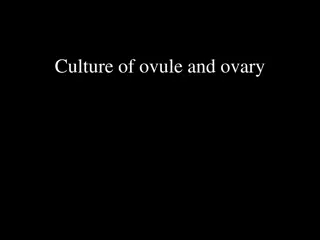Titration Colour Changes
This collection features various experiments in chemistry involving titration and solutions. It includes procedures such as standardizing hydrochloric acid using sodium carbonate, titrating hydrochloric acid with sodium hydroxide to produce sodium chloride, determining the concentration of ethanoic
0 views • 10 slides
Understanding Syrups: Types, Formulations, and Storage Considerations
Syrups are sweet, viscous liquids used in pharmaceutical preparations. They can be non-medicated for flavoring or medicated for therapeutic purposes. There are sugar-based and sugar-free syrups, with sucrose preferred for its purity and handling ease. Preservatives like benzoate and sorbic acid are
5 views • 16 slides
Assessment and Control of Sugar Production Losses in Pakistan
Maximizing sucrose recovery in sugar production is crucial for optimizing operational efficiency and profitability. This study focuses on identifying and managing operational losses within the sugar production process in Pakistan, categorizing losses as determined (easily measurable) and undetermine
2 views • 16 slides
Efflorescence and Exsiccation in Chemistry
Efflorescence refers to the process where a substance loses water to form a lower hydrate or becomes anhydrous due to differences in vapor pressures. Hydrates with vapor pressures greater than the atmosphere tend to exhibit efflorescence. The rate of efflorescence increases with temperature. Exsicca
0 views • 103 slides
Understanding Mixtures and Separation Techniques
Explore the concepts of mixtures and separation, from the definition of dominant and recessive alleles to the advantages of electron microscopes. Learn about identifying pure substances, differences between pure and impure substances, and techniques like filtration and crystallization for separation
1 views • 19 slides
Understanding Carbohydrates in Living Organisms
Carbohydrates, along with proteins, lipids, and nucleic acids, are essential macromolecules in living organisms. They are made up of carbon, hydrogen, and oxygen in a 1:2:1 ratio. Carbohydrates provide the main energy source for living things, with examples including glucose, fructose, and sucrose.
0 views • 58 slides
Understanding Movement of Substances Through Cell Membrane
Substances enter and leave cells through diffusion and osmosis processes, driven by concentration gradients. The cell membrane plays a crucial role in selectively allowing substances to pass, ensuring cell survival. Osmosis can be demonstrated using Visking tubing, showing water molecules moving whi
0 views • 15 slides
Understanding Magmatic Differentiation and Magma Mixing
Magmatic differentiation is the process through which a single homogeneous magma can produce diverse rock types by generating fractions of different compositions. This variation in igneous rocks results from mechanisms like fractional crystallization, liquid immiscibility, vapor transport, and diffu
1 views • 29 slides
Understanding Continuous Pan Boiling in Sugar Processing
Continuous pan boiling is a key process in sugar production, involving multiple compartments where massecuite is heated and circulated. This method ensures efficient crystallization and control of brix levels for optimal sugar quality. The design, operation, and control of continuous pans play a vit
0 views • 11 slides
Isolation of AM Fungi by Wet Sieving and Sucrose Gradient Methods
Wet sieving is a popular technique to isolate different sizes of spores from soil samples. Developed by Gerdemann and Nicolson in 1963, this method involves passing an aqueous suspension through different sieves to collect spores of varying sizes. The process includes agitating the soil-water mixtur
0 views • 14 slides
Understanding Crystallization Process: Key Steps and Factors
Crystallization is a process where material deposits from a supersaturated solution, forming microcrystals that grow into larger crystals. Nucleation and growth are essential steps, with supersaturation driving crystal formation. Factors like temperature and seeding influence the process, leading to
1 views • 21 slides
Crystallization Principles in Chemical Engineering: Understanding Crystal Formation and Purification Methods
Crystallization is a key process in chemical engineering, involving the formation of solid particles within a homogeneous phase to obtain pure chemical substances. This article discusses the principles of crystallization, the importance of crystal size control, equilibria in the process, and the con
1 views • 40 slides
Crystallization Process in Chemical and Petroleum Industries
Crystallization is a purification method used in industries to produce crystalline materials like sugar and citric acid. It involves nucleation and crystal growth stages. Key terms include nucleation, solubility, and supersaturation, impacting crystal formation. Various methods like cooling, evapora
1 views • 19 slides
Dried Ice Cream Mix in Dairy Technology: Advancements and Manufacturing Process
Ice cream manufacturing faces challenges during lean seasons due to milk shortages. Dried ice cream mix powder offers a solution with benefits like reduced storage space, ease of packaging, and lower transportation costs. The composition includes milk fat, protein, sucrose, stabilizers, and emulsifi
1 views • 13 slides
Understanding Textures of Igneous Rocks in Geology
Structures associated with igneous rocks are primary features that contribute to their strength, distinguish rock groups, and reveal origin. Textures, like crystalline patterns, indicate cooling and crystallization processes. Different cooling rates lead to varied textures such as holocrystalline, h
0 views • 16 slides
Sugar Processing Control Formulas and Parameters
Explore the key concepts of crystal content, exhaustion, and the SJM formula in sugar processing control. Learn how to calculate crystal content, manage viscosity limitations, maximize sucrose recovery, and apply the SJM formula for sucrose recovery percentage. Understand the factors affecting exhau
1 views • 8 slides
Separating Components of Ternary Mixtures: Experiment and Methods
Experiment aims to separate sand, sodium chloride, and calcium carbonate in a mixture to calculate percentages and recovery. Explore various methods like chromatography, distillation, extraction, centrifugation, crystallization, and sublimation for component separation.
1 views • 30 slides
Separation and Purification of Organic Compounds: Methods and Techniques
The separation and purification of organic compounds are essential processes to obtain pure products, as impurities and side reactions can affect the quality of the compounds. Methods such as solution and filtration, crystallization, distillation, extraction, sublimation, and chromatography are comm
8 views • 15 slides
Understanding Translocation in the Phloem
This lecture explores the process of translocation in the phloem, supported by evidence from studies such as aphid experiments, ringing experiments, and the use of radioactive isotopes. It delves into the materials translocated in phloem sap, including water, sucrose, non-reducing sugars, nitrogen c
5 views • 18 slides
Understanding Sucrose Hydrolysis and Reducing Sugars in Carbohydrate Chemistry
This content delves into the mechanisms of sucrose hydrolysis through non-enzymatic and enzymatic processes, highlighting disaccharides like sucrose, lactose, and maltose. It explores the significance of glycosidic bonds in carbohydrate structures and discusses the reducing capacity of sugars such a
7 views • 16 slides
Understanding Nonelectrolytes in Solutions
Physical properties of substances are classified into colligative, additive, and constitutive properties. Colligative properties depend on the number of particles in a solution and are similar for different nonelectrolytes. Additive properties are based on the total contribution of atoms, while cons
1 views • 14 slides
Experimenting with Supersaturated Solutions: Rock Candy Creation
Exploring the phenomenon of supersaturated solutions through an experiment creating rock candy. The solubility of sucrose in water is observed at different temperatures, showcasing how more sugar can dissolve in a hot solution than in a cold one. The process of supersaturation and crystallization is
0 views • 11 slides
Exploring Tupelo Honey Varieties_ Which One Is Right for You_
Tupelo honey, often misspelled as \u2018Tupalo honey\u2019, is a rare and prized variety that\ncaptivates honey enthusiasts worldwide. Known for its distinctive flavor, smooth\ntexture, and resistance to crystallization, this golden elixir offers a u
0 views • 5 slides
Understanding Evaporation Principles in Sugar Processing
Evaporation plays a crucial role in sugar processing by removing water from solutions to concentrate sucrose. This process involves boiling liquor, vaporizing water through heat, and crystallizing sucrose. Learn about the boundary between evaporation and sugar boiling, quantity of water to be evapor
5 views • 38 slides
Supercooling Different Types of Water Experiment
This experiment explores the process of supercooling different types of water to understand which type can maintain a liquid state below zero degrees Celsius. The procedure involves cooling the water below its freezing point without it solidifying, aided by adding ice and monitoring temperatures. Th
1 views • 18 slides
Understanding Solutions and Solubility in Chemistry
Explore the concepts of solutions, solvents, solutes, and solubility in chemistry through investigations with various substances and solvents. Learn how to differentiate between dilute, concentrated, and saturated solutions, measure solubility, create solubility curves, and understand crystallizatio
0 views • 36 slides
Understanding Carbohydrates: Composition, Structure, and Function
Carbohydrates are composed of carbon, hydrogen, and oxygen in a specific ratio. Monosaccharides such as glucose, fructose, and galactose are carbohydrate monomers, while polysaccharides like lactose, sucrose, starch, cellulose, and glycogen are carbohydrate polymers. The chemical formula for glucose
0 views • 8 slides
Understanding Olivine Equilibrium in Calculating Original Magma Composition
The process involves analyzing olivine in basaltic rocks, selecting olivine with the highest Fo content, calculating the melt composition in equilibrium with this olivine using the distribution coefficient (KD), and determining the potential temperature (Tp) based on the MgO content. The distributio
0 views • 30 slides
Petrology and Geochemistry Study of Ongonites from Ary-Bulak Massive
Investigating the composition and crystallization of ongonites, this study conducted experiments on rocks from Ary-Bulak at varying conditions. The geological structure, facies zonation, and age of the ongonites were analyzed. Ongonites were found to be a subvolcanic analogue of rare metal LiF grani
0 views • 30 slides
Measurement of Oxygen Concentration in Sodium with Plug Indicator FR-22
Determining oxygen concentration in sodium using plug indicators is crucial for experimental facilities and nuclear reactors. This involves lowering sodium temperature slowly until sodium oxide crystallization begins, indicating saturation temperature (TS). Several solubility equations exist for cal
0 views • 6 slides
Understanding Analytical Chemistry: Solutions and Miscibility
Explore the fundamentals of solutions in analytical chemistry, including the types of solutions, role of solutes and solvents, and the concept of miscibility. Learn about the six types of solutions based on phases, the general rule of miscibility, and the solution process involving dissolution and c
0 views • 17 slides
Exploring Diverse Igneous Geology in and around the Columbia Hills
Studying the diverse igneous geology in and around the Columbia Hills provides insights into Martian atmosphere, volatile budget, age, source characteristics, cooling history, and more. Researchers have uncovered valuable information by coupling unaltered igneous rocks with meteorites and surface sp
0 views • 19 slides
Chemistry Revision: Atomic Structure and the Periodic Table - AQA Trilogy
Explore key concepts in Chemistry Revision for AQA Trilogy including atomic structure, periodic table organization, separation techniques, symbol equations, electron structures, isotopes, and more. Learn about burning magnesium, crystallization, chromatography, fractional distillation, and propertie
0 views • 10 slides
Techniques for Separating Mixtures: A GCSE Guide
Explore various separating techniques such as chromatography, distillation, filtration, and crystallization for different mixtures in a GCSE science context. Learn how to separate substances like solutes, solvents, liquids with similar boiling points, magnesium, salt, and more. Engage in a challengi
0 views • 5 slides
Understanding Anthracene: A Polycyclic Aromatic Hydrocarbon
Anthracene, a polycyclic aromatic hydrocarbon, is composed of three fused benzene rings and exhibits unique properties such as a blue fluorescence when crystallized with benzene. It is commonly found in coal tar and has various industrial applications, including dye production, smoke screens, wood p
0 views • 25 slides
Exploring Tool.Box.Living.Lab: A Collaborative Innovation Platform
The Tool Box Living Lab (TBLL) is an open innovation research method that fosters collaboration among diverse profiles to generate ideas and solutions. It focuses on co-creation with end users and stakeholders in a real-life setting, promoting the emergence of common views, innovations, and collabor
0 views • 15 slides
Understanding Mole Calculations and Its Applications
Dive into the world of mole calculations with Chapter 5 homework assignments, exploring concepts such as mole weight, the dozen concept, and sweet mole calculations. Discover the significance of moles in chemistry and how they relate to everyday scenarios like calculating the weight of eggs and unde
1 views • 28 slides
Formation of Salt Deposits: Processes and Mineral Resources
Understanding the processes involved in the formation of chemical sedimentary rocks, particularly evaporite deposits like salt, is crucial for inferring potential mineral resources. This involves concepts such as evaporation, chemical weathering, crystallization, and lithification, which link togeth
0 views • 4 slides
Essential Nutrients for Plant Tissue Cultures: A Comprehensive Guide
The composition of culture media for plant tissue cultures includes inorganic and organic nutrients, sources of energy like sucrose and amino acids, and essential macro and micronutrients. Providing gas exchange, waste removal, and growth regulators, the medium supports plant growth by offering acce
0 views • 22 slides
In Vitro Culture of Ovule and Ovary for Haploid Plant Production
In vitro culture of unpollinated ovaries and ovules offers an alternative method for haploid plant production. This process involves isolating and culturing ovules in a chemically defined nutrient medium to understand zygote development and embryo maturation stages. Techniques for collecting, prepar
0 views • 34 slides

